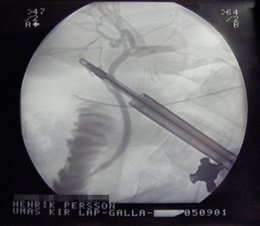Ultrasonography has been the screening test of choice for use in the diagnosis of acute cholecystitis. Although ultrasonography is an effective and easily accessible diagnostic modality, it can depict calculi only in the gallbladder and not in the cystic duct. Being aware of the presence of an impacted calculus within the gallbladder neck or cystic duct is important in identifying patients who may develop serious complications of acute cholecystitis. For this reason, other signs, such as gallbladder wall thickness, fluid collection and enlargement of the gallbladder, have been used to aid diagnosis. Magnetic resonance (MR) cholangiography has proved accurate in the diagnosis of bile duct obstruction and choledocholithiasis. Park and associates evaluated the clinical usefulness of MR cholangiography in the diagnosis of acute cholecystitis.
Thirty-five patients with symptoms of acute cholecystitis underwent both ultrasonography and MR cholangiography before cholecystectomy. The images were evaluated, and the results were compared with surgical findings with respect to gallbladder wall thickness and the presence and location of calculi.
Ultrasonography depicted only one of the seven cystic duct calculi (14 percent), but MR cholangiography depicted all of the calculi. There were no false-negative results on cholangiography. One cystic duct calculus suggested on cholangiography was not found at surgery. Fourteen patients had a calculus impacted within the gallbladder neck. Two of the calculi were not demonstrated on ultrasonography. MR cholangiography showed all of the gallbladder neck calculi, and there were no false-negative or false-positive results on imaging of the gallbladder neck.
Eleven patients had floating calculi within the gallbladder lumen. Ultrasonography depicted all of these calculi, but MR cholangiography failed to depict one of them. On a patient-for-patient basis, ultrasonography demonstrated a sensitivity of 62 percent in the diagnosis of cystic duct obstruction, a specificity of 100 percent and an accuracy of 77 percent. MR cholangiography demonstrated a sensitivity of 100 percent, a specificity of 93 percent and an accuracy of 97 percent. In the 29 patients with surgically confirmed thickening of the gallbladder wall, ultrasonography demonstrated a sensitivity of 96 percent, a specificity of 83 percent and an accuracy of 94 percent. MR cholangiography demonstrated a sensitivity of 69 percent, a specificity of 83 percent and an accuracy of 71 percent.
Results of this study demonstrated 100 percent sensitivity for MR cholangiography in the diagnosis of both cystic duct calculi and gallbladder neck calculi. This is much better than the 14 percent and 86 percent sensitivity demonstrated with ultrasonography. The precise location of the calculi was visualized on MR imaging but not on ultrasonography. The Murphy sign, which is useful in the diagnosis of acute cholecystitis on ultrasonography, is not demonstrated on cholangiography. Thus, MR cholangiography should be accompanied by clinical symptoms, laboratory data or ultrasonography to help accurately distinguish acute cholecystitis from chronic cholecystitis.
The authors conclude that MR cholangiography is superior to ultrasonography in the depiction of the causes of cystic duct obstruction, especially cystic duct calculi and calculi in the gallbladder neck. Cost effectiveness of MR cholangiography in this situation remains to be determined. However, when ultrasonography is not diagnostic, MR cholangiography can contribute to management and planning in patients who may develop serious complications of acute cholecystitis.
Park MS, et al. Acute cholecystitis: comparison of MR cholangiography and US. Radiology December 1998; 209:781-5.
COPYRIGHT 1999 American Academy of Family Physicians
COPYRIGHT 2000 Gale Group



